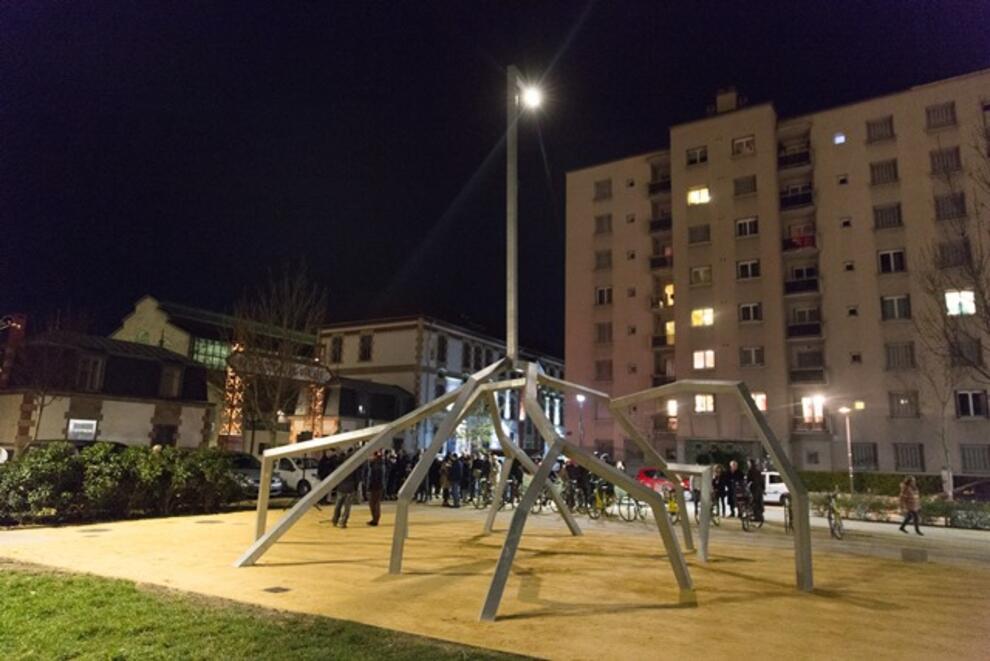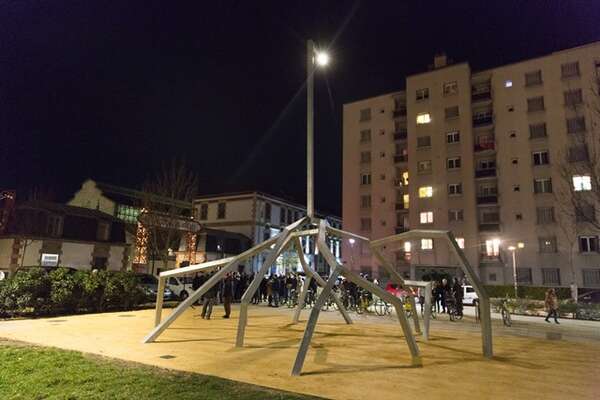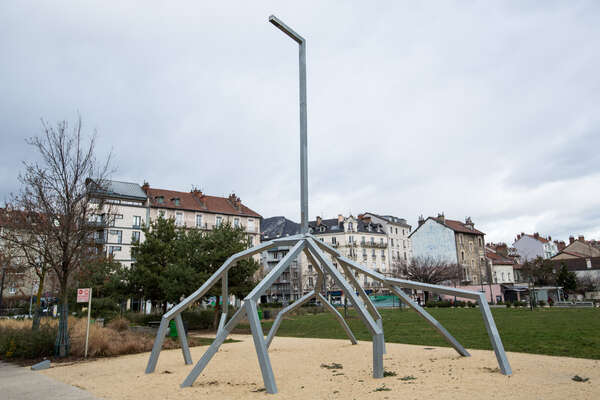
Les Racines du Mal, Didier FAUSTINO

The Roots of Evil, 2006, galvanized steel sculpture with electrical lighting system by Didier Faustino (1968 - )
Although this monumental work is made from long-lasting industrial materials it nevertheless retains an organic feel. Its arms, spreading out in a seemingly anarchic fashion, appear to have been shaped by nature, coming together more than three metres off the ground and supporting a perfectly vertical mast. The tip of Roots of Evil is fitted with a lighting system and gives a new reading of the notion of public street lighting. The work was designed for the Sao Paulo Biennale in Brazil in 2006 on the theme of “How to live together?” It evokes the branches of an upturned tree or, as its title suggests, roots coming out of the ground. The Roots of Evil (the same title as the science fiction novel written in 1995 by the author M.G. Dantec, originally from Grenoble) echoes the tragic history of the town’s famous Square des Fusillés. Firmly inscribed into the urban landscape, the sculpture invites people to come together and creates exchange.
From 1995 on, the French artist and architect Didier Faustino was already working on the relationship between body and space, at the frontier of art, architecture and design. His approach takes on many diverse forms, from installation to experimentation, from the creation of subversive artworks to making spaces favourable for heightening the senses. His projects are characterised by their fictional dimension, their critical vision, and the way in which they free themselves from conventional codes.
This work has been on loan to the town of Grenoble from the National Centre for Visual Arts since 2016.
The town of Grenoble has more than 150 works installed in public places that we invite you to discover thanks to several trails across the town and on the grenoble-patrimoine.fr website. These trails have been created with the help of the Département of Isère and the Auvergne-Rhône-Alpes Regional Cultural Affairs Directorate.
Cette œuvre monumentale réalisée avec un matériau industriel et pérenne - acier galvanisé - n'en est pas moins organique. Ses bras, dont le déploiement anarchique semble avoir été guidé par la nature, se rejoignent en un point, à plus de trois mètres du sol, pour soutenir un mat parfaitement vertical. Les Racines du mal, dont le sommet est équipé d’un système d'éclairage, offre une relecture du lampadaire public. L’œuvre a été conçue pour la biennale de Sao Paulo au Brésil en 2006, dont la thématique était "Comment vivre ensemble ?". Elle évoque les ramifications d’un arbre retourné ou, comme son titre le suggère, celles de racines sorties de terre. Les Racines du Mal - titre éponyme du roman d'anticipation écrit en 1995 par l’auteur d’origine grenobloise M.G. Dantec - fait écho à l’histoire tragique du square des Fusillés. Inscrite dans le paysage urbain, la sculpture invite au rassemblement et à l’échange.
Artiste et architecte français, Didier Faustino (1968 - ) travaille dès 1995 sur la relation entre le corps et l’espace, sur la frontière entre art, architecture et design. Son approche est multiforme, allant de l’installation à l’expérimentation, de la création d’œuvres plastiques subversives à celle d’espaces propices à l’exacerbation des sens. Ses projets se caractérisent par leur dimension fictionnelle, leur regard critique, et leur affranchissement des codes.
Cette œuvre est un dépôt du Centre National des Arts Plastiques à la Ville de Grenoble en 2016. La Ville de Grenoble compte plus de 150 œuvres implantées sur l’espace public, que nous vous invitons à découvrir à travers plusieurs parcours dans la ville et sur le site grenoble-patrimoine.fr. Ces parcours ont été réalisés avec l’aide du Département de l’Isère et de la Direction Régionale des Affaires Culturelles Auvergne-Rhône Alpes.
Square des Fusillés, Grenoble
Période historique
8ème période : XXIeClassé en
- Patrimoine Monumental (Artistique, culturel et scientifique)
Thématique(s)
- Art et culture










